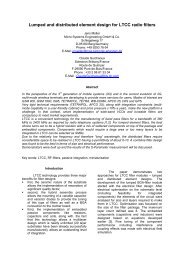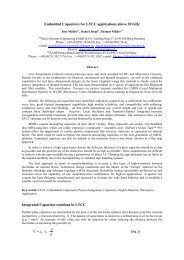View - Micro Systems Engineering
View - Micro Systems Engineering
View - Micro Systems Engineering
Create successful ePaper yourself
Turn your PDF publications into a flip-book with our unique Google optimized e-Paper software.
Heatsink Via stack Type Failure [%]<br />
w/o<br />
w/o<br />
2 layer<br />
4 layer<br />
Stripline (Fig. 3a) 0<br />
Coplanar line (Fig. 3b) 0<br />
Constant via diameter: 250 µm (Fig. 2b) 80<br />
Altern. via diameter: 250/130µm (Fig. 2c) 20<br />
Constant via diameter: 250 µm (Fig. 2e) 60<br />
Altern. via diameter: 250/130µm (Fig. 2f) 0<br />
with all types all types (Fig. 2a/d) 0<br />
X-ray analysis revealed no major problems<br />
with heat sink soldering. Heat sinks soldered with<br />
AuSn had small voids (less than 10%) whereas the<br />
SnAgCu solder was almost void free (Fig. 6 and 7).<br />
Fig. 6: X-ray picture of a heat sink soldered with<br />
AuSn (small voids visible)<br />
Fig. 7: X-ray picture of a heat sink soldered with<br />
SnAgCu<br />
Table 1: He fine leak test results<br />
Package RF Performance<br />
The two line configurations (Fig. 3) needed<br />
to be optimized for best wave impedance control [4].<br />
Critical areas are the transitions underneath the wall<br />
to enter the inner cavity. The dielectric cover causes<br />
an impedance step towards lower values. Therefore, a<br />
line width reduction is mandatory for compensation.<br />
Vias, surrounding the lines for shielding purposes and<br />
ground connection, play an important role for the<br />
wide band behaviour of the transition. Their location,<br />
size and pitch determine the maximum possible<br />
frequency with low return loss. Fig. 8 and 9 depict the<br />
structure of the transition for both line types.<br />
CST <strong>Micro</strong>wave Studio was used to simulate<br />
and optimize the transitions.<br />
Fig. 8: Structural model of the stripline<br />
configuration<br />
The outer connection was designed as a<br />
grounded coplanar line allowing direct contacting<br />
with microwave probes (250 µm pitch). The test<br />
packages were measured with a network analyser and<br />
Z-Probes from SÜSS <strong>Micro</strong>Tech up to 50 GHz<br />
between the two outer connections (4 line transitions).<br />
Measurement results are shown in Fig. 10.







